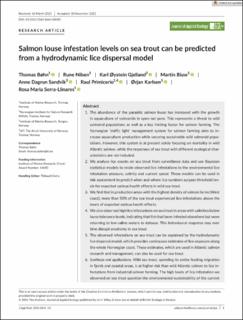| dc.contributor.author | Bøhn, Thomas | |
| dc.contributor.author | Nilsen, Rune | |
| dc.contributor.author | Gjelland, Karl Øystein | |
| dc.contributor.author | Biuw, Martin | |
| dc.contributor.author | Sandvik, Anne Dagrun | |
| dc.contributor.author | Primicerio, Raul | |
| dc.contributor.author | Karlsen, Ørjan | |
| dc.contributor.author | Serra Llinares, Rosa Maria | |
| dc.date.accessioned | 2022-01-19T10:13:43Z | |
| dc.date.available | 2022-01-19T10:13:43Z | |
| dc.date.created | 2022-01-01T09:16:56Z | |
| dc.date.issued | 2021 | |
| dc.identifier.citation | Journal of Applied Ecology. 2021, 1-11. | en_US |
| dc.identifier.issn | 0021-8901 | |
| dc.identifier.uri | https://hdl.handle.net/11250/2838170 | |
| dc.description.abstract | The abundance of the parasitic salmon louse has increased with the growth in aquaculture of salmonids in open net pens. This represents a threat to wild salmonid populations as well as a key limiting factor for salmon farming. The Norwegian ‘traffic light’ management system for salmon farming aims to increase aquaculture production while securing sustainable wild salmonid populations. However, this system is at present solely focusing on mortality in wild Atlantic salmon, while the responses of sea trout with different ecological characteristics are not included. | en_US |
| dc.language.iso | eng | en_US |
| dc.title | Salmon louse infestation levels on sea trout can be predicted from a hydrodynamic lice dispersal model | en_US |
| dc.type | Peer reviewed | en_US |
| dc.type | Journal article | en_US |
| dc.description.version | publishedVersion | en_US |
| dc.source.pagenumber | 1-11 | en_US |
| dc.source.journal | Journal of Applied Ecology | en_US |
| dc.identifier.doi | 10.1111/1365-2664.14085 | |
| dc.identifier.cristin | 1973215 | |
| cristin.ispublished | true | |
| cristin.fulltext | original | |
| cristin.qualitycode | 2 | |
